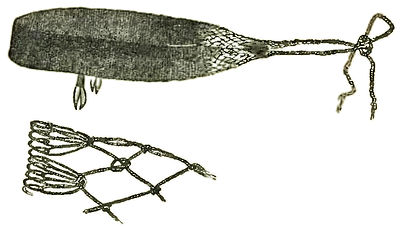The young males wore wallaby skins, cut into shreds and fastened by a string around the loins. It was worn until the whiskers grew, and the upper incisors—Wid-don-wo-ri—were knocked out.
The women, when travelling, carried a bag made of the leaves of some aquatic plant or flag, in which their fish, game, and yams were placed. The bag was called Koorn-goo. Each man also had a bag, but larger, in which he carried kangaroo and emu meat. This bag, too, was called Koorn-goo.
Dr. Gummow has sent me specimens of the ornaments worn by the natives of the Lower Murray:—

|
| FIG. 24. |
The band tied round the head, extending from the occiput over the parietal bones to the place of the frontal suture, called Mar-rung-nul, is shown in Fig. 24. This specimen was obtained by Dr. Gummow from one of the old natives. This ornament is closely woven, and to the eye resembles a thick coarse cloth, but it is really soft and pleasant to the touch. It is made of the fibrous root of the wild clematis (Mo-u-ee). It is exceedingly strong. The length of the band is twelve inches, and the breadth one inch and a quarter. Dr. Gummow says that these bands are usually made by the women. Wing feathers of the cockatoo are stuck in the band, one on each side of the head. The feathers are called Wyrr-tin-nay. This band is worn by males only.
Mr. A. F. Sullivan, of Bulloo Downs, Cuunamulla (Queensland), gave me a specimen of the Mar-rung-nul, made of the fur of the opossum. It is very soft, and well and closely woven. The band is fourteen inches in length. When worn by the natives, it is made white with clay or burnt gypsum.

|
| FIG. 25. |
The band of network (Fig. 25) Dr. Gummow says is named Moolong-nyeerd. It is worn across the forehead, with the kangaroo teeth as pendants, which, when lashed together, are known as Leangerra. When stretched, as it
